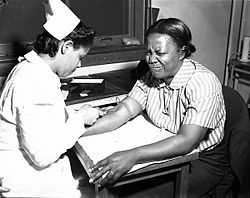疼痛
一种与组织损伤或潜在组织损伤相关的感觉、情感、认知和社会维度的痛苦体验 来自维基百科,自由的百科全书
身體的疼痛(pain)是由疾病、创伤、外在伤害性刺激,伴随现有的或潜在的组织损伤,所引起在知觉上或情绪上难受的、不愉快的感觉。疼痛是主观性的,影响的范围可为身体局部或整体,属一种复杂的生理、心理活动。
| 疼痛 | |
|---|---|
 | |
| 一位婦女在抽血時的痛苦表情 | |
| 类型 | 症狀、不愉快性[*]、痛苦、知觉、sensation perception[*] |
| 分类和外部资源 | |
| 醫學專科 | 神經內科 |
| ICD-10 | R52.9 |
| DiseasesDB | 9503 |
| MedlinePlus | 002164 |
出於臨床研究的需要,國際疼痛研究國際疼痛研究協會將疼痛定義為「由真正存在或潛在的身體組織損傷所引起的不舒服知覺和心理感覺」。[1][2]
疼痛是主觀的感覺,早於1968年疼痛處理專家马戈·麦加费利首次提出一個在護理學界普遍使用的定義:「一個人說感到痛,這就是痛;他說痛仍在,痛就仍在。」(原文:Pain is whatever the experiencing person says it is, existing whenever he says it does.)[3][4]
身體疼痛是看醫生的主要原因;在美國,有一半看醫生的人是因為疼痛,是最普遍的原因。[5]疼痛也是大部分病患的徵狀,可根據維持時間、強度、種類(如火燒、針刺感等)、位置等來診斷。通常疼痛會自然消退,或通過簡單的止痛處理後消退,這可稱作「急性」疼痛。但有時疼痛本身已是一種病患,如慢性疼痛。近年痛症引起了不同學科專家的關注,如藥理學、神經生物學、護理學、物理治療和心理學,並形成了疼痛管理這門在麻醉學、物理治療、神經學、精神科等專科之下的附屬專科[6]。
用語區分
汉语中,痛与疼是近义词;在语意上,痛的含义较广泛,痛包含疼,且痛大于疼。“痛”较偏向慢性的、长久持续的、深入的、钝挫的疼痛。“疼”则较偏向急性的、短暂间断的、浅表的、热灼的、开放发散的、尖锐的疼痛[7]。
身體的“疼痛”,是主觀、有意識的感覺。而“痛覺”,則指感受器、周圍神經系統、脊髓和腦受有害刺激而引起的無意識活動[8]。一般而言,痠、痛、乏的症状与肌肉、软组织损伤较有关,而麻、抽、胀的感受则多和神经病变较相关;神经痛及神經性疼痛则为例外情形。
分類
痛觉感受器受到化學、熱力或撞擊等可損傷身體組織的刺激就可能會產生疼痛。若神經系統由病患或損傷而受損,可引致神經痛症或神經性病變痛症[9]。由感受器受刺激和神經系統受損引起的疼痛是兩大主要疼痛發生機制,第三類是精神性疼痛,較為罕見。
其中,痛觉感受器引起的疼痛可細分為三種:[10]
疼痛与疾病
疼痛是许多疾病的常见或主要症状,如脑肿瘤的头痛、冠心病发作时的胸痛,胆石症的胆绞痛和腹痛、晚期癌症患者的癌性疼痛等。有些疼痛本身就是一种疾病,如帶狀皰疹的神经痛、三叉神经痛。疼痛不仅给患者带来痛苦,而且还对人体中樞神經、循环、呼吸、内分泌、消化和自主神經等系统造成不良影响,甚至是某些严重的、威胁生命的疾病症状。[11]
參見
註釋和參考
外部連結
Wikiwand - on
Seamless Wikipedia browsing. On steroids.
